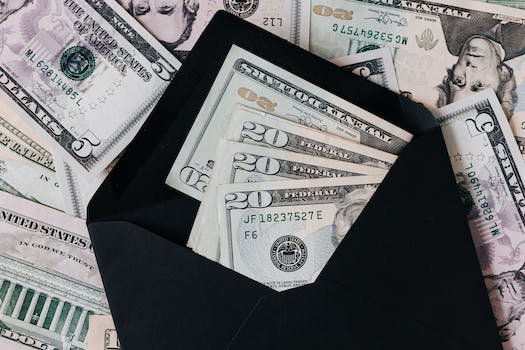How To Save Money With Envelopes
Introduction

Saving money is an important aspect of financial planning. One effective way to save money is by using envelopes. Envelope budgeting is a simple and effective method of managing your finances. It involves allocating a certain amount of money for each expense category and putting that money in an envelope. This way, you can easily track your spending and avoid overspending. In this article, we will discuss how to save money with envelopes.
Creating a Budgeting System with Envelopes
Budgeting is an essential part of managing your finances. It helps you keep track of your expenses and ensures that you have enough money to cover your bills and save for the future. However, creating a budgeting system can be challenging, especially if you don’t know where to start. One effective way to manage your budget is by using envelopes.
Envelopes are a simple and effective way to manage your money. They allow you to allocate a specific amount of money for each category of your budget, such as groceries, entertainment, and transportation. By using envelopes, you can avoid overspending and ensure that you have enough money to cover your expenses.
To create a budgeting system with envelopes, you need to follow these simple steps:
Step 1: Determine your monthly income
The first step in creating a budgeting system with envelopes is to determine your monthly income. This includes your salary, any additional income, and any government benefits you receive. Once you have determined your monthly income, you can move on to the next step.
Step 2: List your expenses
The next step is to list all your expenses. This includes your fixed expenses, such as rent, utilities, and insurance, as well as your variable expenses, such as groceries, entertainment, and transportation. Be sure to include all your expenses, no matter how small they may seem.
Step 3: Allocate your expenses to envelopes
Once you have listed all your expenses, you can allocate them to envelopes. You can use physical envelopes or digital envelopes, such as budgeting apps. Allocate a specific amount of money for each category of your budget, such as groceries, entertainment, and transportation. Be sure to allocate enough money for each category to cover your expenses for the month.
Step 4: Track your expenses
The next step is to track your expenses. This involves keeping track of how much money you spend in each category. You can do this by keeping receipts or using a budgeting app. By tracking your expenses, you can ensure that you stay within your budget and avoid overspending.
Step 5: Adjust your budget as needed
Finally, you need to adjust your budget as needed. If you find that you are overspending in a particular category, you may need to adjust your budget and allocate more money to that category. Similarly, if you find that you are underspending in a particular category, you may need to adjust your budget and allocate less money to that category.
Using envelopes to manage your budget is a simple and effective way to save money. By allocating a specific amount of money for each category of your budget, you can avoid overspending and ensure that you have enough money to cover your expenses. However, it is important to track your expenses and adjust your budget as needed to ensure that you stay within your budget.
In conclusion, creating a budgeting system with envelopes is an effective way to manage your finances. It allows you to allocate a specific amount of money for each category of your budget, track your expenses, and adjust your budget as needed. By following these simple steps, you can save money and achieve your financial goals.
Maximizing Savings with Envelope Categories
As we navigate through life, we are constantly looking for ways to save money. One of the most effective ways to do this is by using envelopes to categorize our expenses. This simple yet powerful tool can help us stay on track with our budget and maximize our savings.
The first step in using envelopes to save money is to create categories. These categories should be based on your monthly expenses, such as groceries, gas, entertainment, and bills. Once you have identified your categories, you can assign a specific amount of money to each one.
Next, you will need to label your envelopes with the appropriate category. This will help you stay organized and ensure that you are putting the right amount of money into each envelope. You can use plain white envelopes or get creative and decorate them with stickers or markers.
Once your envelopes are labeled, it’s time to start filling them up. At the beginning of each month, take the amount of money you have assigned to each category and put it into the corresponding envelope. For example, if you have allocated $200 for groceries, put $200 into your grocery envelope.
As you go through the month, use the money in each envelope for its designated purpose. When the money in an envelope runs out, you know that you have reached your limit for that category. This will help you avoid overspending and stay within your budget.
Using envelopes to categorize your expenses can also help you identify areas where you can cut back. If you find that you are consistently running out of money in a certain category, it may be time to reevaluate your spending habits and see where you can make adjustments.
Another benefit of using envelopes is that it can help you save money for larger expenses. For example, if you want to take a vacation in six months, you can create a “vacation” envelope and start putting money into it each month. By the time your trip rolls around, you will have saved up enough money to cover your expenses without having to dip into your regular budget.
In addition to using envelopes for monthly expenses, you can also use them for one-time expenses. For example, if you need to buy a new appliance or make a home repair, you can create an envelope specifically for that expense and start saving for it in advance.
Overall, using envelopes to categorize your expenses is a simple yet effective way to save money. It helps you stay organized, avoid overspending, and identify areas where you can cut back. By taking the time to create categories and fill your envelopes each month, you can maximize your savings and achieve your financial goals.
Tips for Sticking to Your Envelope Budget
Budgeting is an essential part of managing your finances. It helps you keep track of your expenses and ensures that you don’t overspend. One popular budgeting method is the envelope system. This system involves dividing your money into different categories and putting them in separate envelopes. Each envelope represents a specific expense, such as groceries, rent, or entertainment. The idea is to only spend the money in each envelope on its designated expense. This system can be an effective way to save money, but it requires discipline and commitment. Here are some tips for sticking to your envelope budget.
Firstly, it’s important to create a realistic budget. You need to know how much money you have coming in and going out each month. This will help you determine how much money you can allocate to each envelope. Be honest with yourself about your expenses and don’t underestimate how much you spend. It’s better to overestimate than to run out of money halfway through the month.
Once you’ve created your budget, it’s time to start filling your envelopes. You can use cash or a debit card to withdraw money and put it in each envelope. Make sure you label each envelope clearly and keep them in a safe place. It’s a good idea to keep your envelopes in a secure location, such as a safe or a locked drawer. This will prevent you from accidentally spending money from the wrong envelope.
Next, you need to be disciplined about sticking to your budget. It’s easy to overspend when you have cash in your wallet, but you need to resist the temptation. Only spend money from the designated envelope and avoid using money from other envelopes. If you run out of money in one envelope, don’t borrow from another envelope. Instead, find ways to cut back on expenses or find ways to earn extra income.
One way to stay motivated is to track your progress. Keep a record of how much money you spend from each envelope and compare it to your budget. This will help you see where you’re overspending and where you can cut back. You can also reward yourself for sticking to your budget. For example, if you stay within your grocery budget for the month, treat yourself to a nice dinner or a movie.
Another tip is to be flexible with your budget. Life happens, and unexpected expenses can arise. If you need to adjust your budget, don’t be too hard on yourself. Just make sure you’re still sticking to your overall financial goals. If you need to borrow money from another envelope, make sure you pay it back as soon as possible.
Finally, it’s important to review your budget regularly. Your expenses and income can change over time, so it’s important to adjust your budget accordingly. Review your budget at least once a month and make any necessary changes. This will help you stay on track and avoid overspending.
In conclusion, the envelope system can be an effective way to save money and stick to a budget. It requires discipline and commitment, but the rewards are worth it. By creating a realistic budget, filling your envelopes, being disciplined, tracking your progress, being flexible, and reviewing your budget regularly, you can successfully stick to your envelope budget and achieve your financial goals.
Using Envelopes for Irregular Expenses
As someone who has struggled with budgeting in the past, I have found that using envelopes for irregular expenses has been a game-changer in terms of saving money. Irregular expenses are those that don’t occur on a regular basis, such as car repairs, medical bills, or gifts for special occasions. These expenses can be difficult to plan for, and if you’re not careful, they can quickly eat away at your budget. However, by using envelopes to set aside money for these expenses, you can avoid the stress and financial strain that often comes with unexpected costs.
The first step in using envelopes for irregular expenses is to identify what those expenses are. Take some time to think about the types of expenses that you don’t encounter on a regular basis but that you know will come up at some point. This might include things like home repairs, car maintenance, or even vacations. Once you have a list of these expenses, you can start to allocate money to each one.
To do this, you’ll need to determine how much you need to save for each expense and how often you need to save it. For example, if you know that you’ll need to replace your car’s tires in six months and the cost will be $500, you’ll need to save about $84 per month to reach that goal. You can then create an envelope specifically for car repairs and put $84 in it each month until you reach your goal.
One of the benefits of using envelopes for irregular expenses is that it allows you to break down larger expenses into smaller, more manageable chunks. Instead of feeling overwhelmed by a $500 car repair bill, you can focus on saving $84 each month, which feels much more achievable. This can also help you avoid dipping into your emergency fund or using credit cards to cover unexpected expenses.
Another benefit of using envelopes for irregular expenses is that it helps you prioritize your spending. When you know that you have a set amount of money allocated for car repairs, for example, you’re less likely to spend that money on something else. This can help you avoid impulse purchases and ensure that you’re putting your money towards the things that are most important to you.
Of course, using envelopes for irregular expenses does require some discipline and planning. You’ll need to be consistent about setting aside money each month and resist the temptation to dip into those envelopes for other expenses. However, the payoff is worth it. By being proactive about saving for irregular expenses, you can avoid the stress and financial strain that often comes with unexpected costs.
In conclusion, using envelopes for irregular expenses is a simple but effective way to save money and avoid financial stress. By identifying your irregular expenses, breaking them down into manageable chunks, and prioritizing your spending, you can ensure that you’re prepared for whatever unexpected costs come your way. While it does require some discipline and planning, the peace of mind that comes with knowing you have money set aside for unexpected expenses is well worth the effort.
Transitioning to a Cash-Only Envelope System
As we navigate through life, we are constantly faced with financial decisions. From paying bills to buying groceries, it can be challenging to manage our money effectively. However, there is a simple and effective way to save money that has been around for decades: the envelope system.
The envelope system is a cash-only budgeting method that involves dividing your money into different categories and placing the cash into envelopes labeled with each category. This system helps you to stay on track with your spending and avoid overspending in certain areas.
Transitioning to a cash-only envelope system can be a daunting task, but it is a worthwhile investment in your financial future. Here are some tips to help you make the transition:
1. Determine your budget categories
Before you can start using the envelope system, you need to determine your budget categories. These categories should be based on your monthly expenses, such as rent/mortgage, utilities, groceries, transportation, entertainment, and savings. Once you have determined your categories, label each envelope accordingly.
2. Set a budget for each category
Once you have your categories, it’s time to set a budget for each one. This involves determining how much money you can allocate to each category each month. Be realistic and considerate of your income and expenses. If you find that you are consistently overspending in a certain category, you may need to adjust your budget accordingly.
3. Withdraw cash for each category
Now that you have your budget categories and amounts, it’s time to withdraw cash for each one. This involves going to the bank or ATM and withdrawing the amount of cash you need for each category. Be sure to keep the cash for each category separate and place it in the corresponding envelope.
4. Use the envelopes for all purchases
Once you have your envelopes filled with cash, it’s time to start using them for all purchases. This means that you will only use the cash in each envelope for the corresponding category. For example, if you need to buy groceries, you will only use the cash in your grocery envelope. This helps you to stay on track with your spending and avoid overspending in certain areas.
5. Track your spending
As you use your envelopes, it’s important to track your spending. This involves keeping a record of how much money you spend in each category and how much money you have left. This helps you to stay accountable and make adjustments to your budget if necessary.
Transitioning to a cash-only envelope system may take some time to get used to, but it is a great way to save money and stay on track with your spending. By determining your budget categories, setting a budget for each one, withdrawing cash for each category, using the envelopes for all purchases, and tracking your spending, you can take control of your finances and achieve your financial goals.
Conclusion
Conclusion: Using envelopes to budget and save money is a simple and effective method that can help individuals and families achieve their financial goals. By allocating funds to specific categories and tracking expenses, people can gain greater control over their spending and avoid overspending. With discipline and consistency, envelope budgeting can lead to significant savings and financial stability over time.







